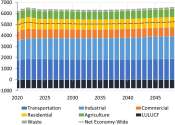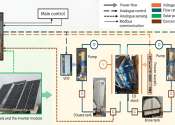Renewable energy is energy generated from natural resources—such as sunlight, wind, rain, tides, and geothermal heat—which are renewable (naturally replenished). In 2006, about 18% of global final energy consumption came from renewables, with 13% coming from traditional biomass, such as wood-burning. Hydroelectricity was the next largest renewable source, providing 3% of global energy consumption and 15% of global electricity generation.
Wind power is growing at the rate of 30 percent annually, with a worldwide installed capacity of 121,000 megawatts (MW) in 2008, and is widely used in European countries and the United States. The annual manufacturing output of the photovoltaics industry reached 6,900 MW in 2008, and photovoltaic (PV) power stations are popular in Germany and Spain. Solar thermal power stations operate in the USA and Spain, and the largest of these is the 354 MW SEGS power plant in the Mojave Desert. The world's largest geothermal power installation is The Geysers in California, with a rated capacity of 750 MW. Brazil has one of the largest renewable energy programs in the world, involving production of ethanol fuel from sugar cane, and ethanol now provides 18 percent of the country's automotive fuel. Ethanol fuel is also widely available in the USA. While most renewable energy projects and production is large-scale, renewable technologies are also suited to small off-grid applications, sometimes in rural and remote areas, where energy is often crucial in human development. Kenya has the world's highest household solar ownership rate with roughly 30,000 small (20–100 watt) solar power systems sold per year.
Some renewable energy technologies are criticised for being intermittent or unsightly, yet the renewable energy market continues to grow. Climate change concerns coupled with high oil prices, peak oil and increasing government support are driving increasing renewable energy legislation, incentives and commercialization. New government spending, regulation, and policies should help the industry weather the 2009 economic crisis better than many other sectors.









